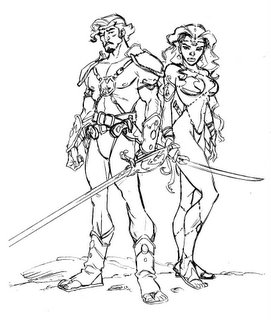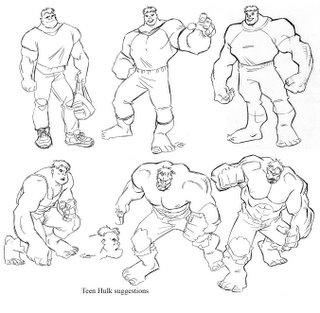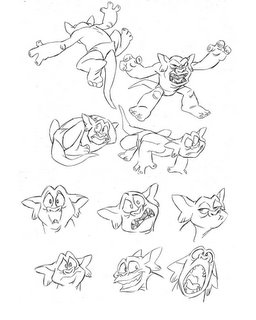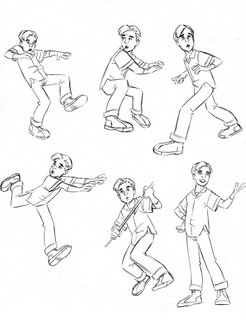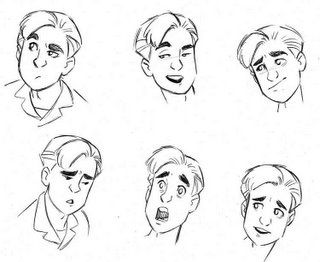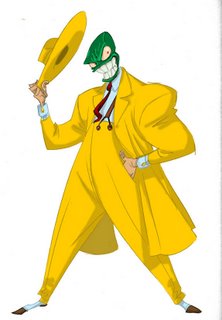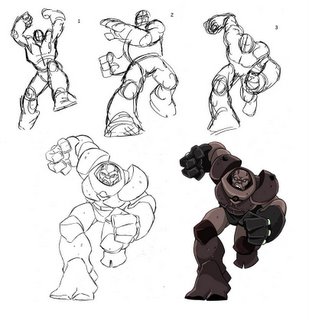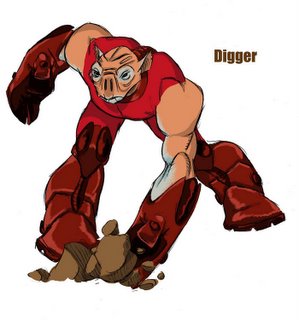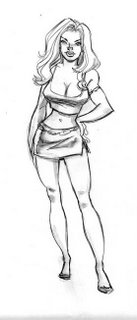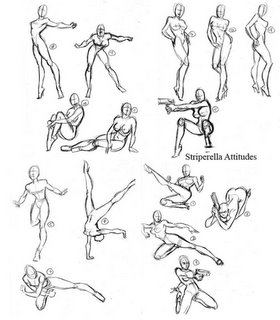STEVE GORDON INTERVIEW
CHARACTER DESIGNER FOR ANIMATION
Tuesday, November 01, 2005
BROUGHT TO YOU BY THE CHARACTER DESIGN BLOGSPOT
IF YOU WOULD LIKE TO SEE MORE CHARACTER DESIGNERS GO TO THE HOME PAGE BY CLICKING HERE
THE INTERVIEW
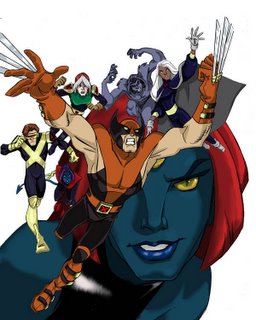
Steve tell me a little bit about yourself, about your life? Where did you go to school, and what classes did you study? What helped prepare you to become the artist that you are today?
I started in the animation biz while I was till in High School. My art teacher saw an ad posted in the trades looking for portfolio submissions and she thought that it would be a good practical experience for me to get a professional critique of my work – what she was really hoping is that it would humble me a little. It seems that in every high school there's always one star art student, at least, and in my high school it was me. I was always able to find a way to use art to my advantage in most of my classes and for a good long Summer I earned a pretty good salary doing pastel portraits at Magic Mountain. Doing these portraits is where I learned to be decisive and quick. It sure didn't hurt my popularity quotient either. My BIG plan was to graduate and go to Art Center of Pasadena and become the next sensation in fantasy illustration ala Frazetta. I had absolutely no desire at the time to go into animation.
Anyway, I submitted my portfolio and shocked everyone by being hired to work full time on Ralph Bakshi's Lord of the Rings feature. After some scrambling around and help by my art teacher and counselor I was able to continue 12 th grade by going to night school. It wasn't until sometime after I started working in studio and got o see the many of the other portfolios that were submitted by the other 'kids' that Ralph hired that my art teacher got her wish. I was definitely humbled and realized how inadequate my art education ha d been. Since then I think I've learned some humility.
After I finished that gig I made plans to return to art school and started to take several art classes until I started to become too busy to do even that. What eventually "helped me become the artist I am today" was being a fan of many of my co-workers’ abilities and talents and doing my best to keep learning and stretching my own skills. With every new job I always try and do it a little different and incorporate something new that I saw and admired or thought I could improve upon.
Most important fact of becoming successful in this industry? Being in the right place at the right time -- and then having the right skills and talent to pull off the job you're given.
How do you go about designing a character, and what goes through your mind, from start to end?
When I start an assignment I try and do as much research as possible. Whether it's researching an established comic character or trying to find a person or an actor that I think fits the type of personality that I envision for the new design. I prefer to stay away from using other animated characters as reference. This holds true whether the designs need to be very straight or go pretty broad. I like to spend a lot of time thinking and researching before I start to draw. The internet has been a huge help with this. I find it imperative that I have a computer with internet access when I work.
I'll give you an example of how I work. When I was designing Captain America for "the Ultimate Avengers " I spent a lot of time looking through Captain America comics and especially the specific comics that we were adapting the story from and trying to determine what made the character and the art unique and try and what aspects of Brian Hitch's (the Ultimates' comic artist) drawing would work or not work in animation. Hitch's drawings were VERY realistic and almost photographic. So I knew that to approximate this look I would have to stay away from my graphic style of straights against curves and exaggerated proportions that I used in X-M:E . I started doing some rough sketches to determine what style and proportions I wanted to go with and slowly came to some decisions. All the while keeping the character's personality in mind and thinking about how he would act and move. Once I was satisfied I needed to go to the next step of tying the real design down. I d id a lot of research into body builders - working on the premise that Cap had been injected with something that worked like steroids. I looked at where I could exaggerate certain muscles to make it obvious he was a body builder and looked at how they stood and held themselves. I find it important to create an attitude for the character even for the basic model pose. I wanted to give the impression that if you were to actually stand next to this guy you would feel his power and strength by just his presence. He needed to feel out of place unless in his Capt A uniform and he needed to look almost uncomfortable in suits and regular clothing. For his face I felt not only did he need to be the standard square jawed super hero, but he needed to feel like he was a farm boy and he could fit in the 1940s. I went through f my reference folders on my computer of actors and started to decide which faces felt right to me. I also researched WWII photos to get a feel for that era and type of guy. In a way it's kind of like casting a film except I can play Dr. Frankenstein and cut and piece different parts together and then improve upon any of the reference I use. I then, of course, had to research hairstyles of the period and clothing and such. By the time I was done I felt happy that I created a design that had the feel of Hitch's but still was unique to me.
What do you think really helps you out in designing a character?
Besides the things I mentioned above (maybe I was TOO detailed?) I need a clear idea of who the character is and what function he/she/it serves in the show. If a voice is available that's always a plus.
From your own experience and maybe from some people that you know, what should we put in our portfolio and what should we not?
When I'm looking to hire a character designer for a show I'm directing I look for good anatomy skills, but not necessarily life drawings. Life drawings seem to be a dime a dozen. Even some of the weakest draftsmen have decent life drawings in their portfolio. This might be peculiar to me, but I look at how someone handles the hands and feet. If they are cheating on their hands and feet I know there might be other problems. The other main thing I look for is how well they can simplify something and how they handle details like ellipses and foreshortening.
What are some of the things that you have worked on?
I've been fortunate enough to move back and forth between TV and film and direct-to-video without any problems. I managed to teach myself enough different skills to allow myself to do this without any real problems (though I'm sure some might disagree with me). I've also worked on children's book adaptations of movies and some illustrations.
Is there a character design you have done that you are most proud of?
I'm proud of most of my designs as well as always feeling like I could improve them further. But I think I really nailed Rogue (in her civvies) and the Scarlet Witch on X-Men: Evolution.

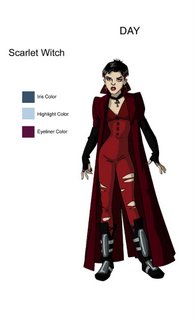
What are you working on now? (If you can tell us)
Currently I'm directing on several direct-to-video features for Stan Lee and IDT/FilmRoman.
Where is the place you would like to work if you had a choice?
Any place where they allow me to have a creative say in the out come of the project...or somewhere that will pay me and not bounce the checks.
Who do you think are the top character designers out there?
There are a lot of them that are very good and I admire, but I really like some of the old guys like Milt Kahl, Alex Toth and Doug Wildey.
How do you go about coloring the character, what type of tools or media do you use?
I used to use a lot of marker, but now I almost never use anything except PhotoShop.
What type of things do you love to draw, and why?
I enjoy women...do I need to explain? And pretty much anything else though I'm not big on Backgrounds. I'll do them if I have to, but will usually try to find a way around them.
What part of designing a character is most fun and easy, and what is most hard?
The most fun I have with character design is when I can start doing the expressions and attitudes. By that point most of the problems have been worked out and I can start giving the design more life and proving my concept is sound. I also enjoy working out walk and run cycles when called for. The most difficult part is trying to discover what the producer or director might have in their head.
What are some of your favorite character designs and least favorite, which you have seen?
I think I'll skip this question on the grounds that it might incriminate me...
What is your most favorite subject to draw?
I thought I covered that already...women...I just wish I was Adam Hughes!!!
What inspired you to become a Character Designer?
Earning money...actually I fell into it by accident. I was on a project where the designer didn't perform up to expectations so I ended up filling the void. From that point on I learned I had a knack for certain types of design.
What are some of the neat things you have learned from other artists that you have worked with or seen?
The list is too long. I've learned from almost everyone that was better than me whether I admired them or not. Come to think of it, I've learned from many that weren't considered as good as me too.
What wisdom could you give us, about being a character designer? Do you have any tips you could give?
I would start by copying designers you like and then trying to do new designs in the artist's style and see if you can fool anyone - or yourself. Most importantly, if you intend on creating designs for someone to animate, learn to animate yourself. I don't know how many times I've tried to animate a design that just couldn't be animated. After you've tried to animate you'll soon learn what a difference it is to work with a good or a bad design.
If people would like to contact you, how would you like to be contacted?
They can use my e-mail address. steve@stevenegordon.com
Finally, do you have any of your art work for sale (sketchbook, prints, or anything) for people that like your work can know where and when to buy it?
I intend on putting a sketchbook together in time for next year's San Diego Comic-Con. Notice I said "intend"? When I have something like that available I'll be sure to let everyone know through my web-site and blog. But I also try to do commissions whenever possible. In fact this time of year tends to get busy...
IF YOU WOULD LIKE TO KNOW MORE ABOUT STEVE GORDON GO TO
http://stevenegordon.com/
CLICK HERE TO GO BACK TO THE CHARACTER DESIGN HOMEPAGE
Subscribe to:
Posts (Atom)

